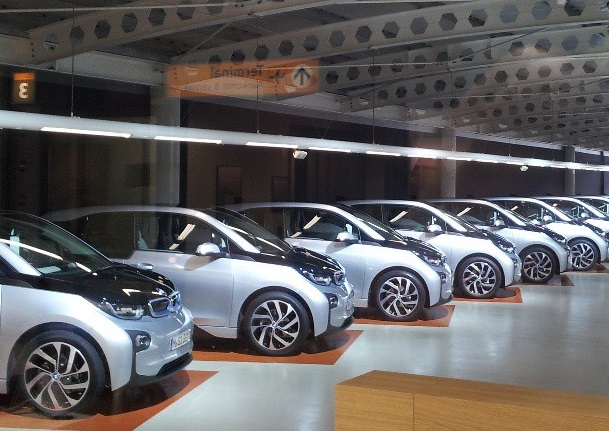![Renault Fluence ZE charging at Better Place charge point in apartment bldg [photo: Brian of London] Renault Fluence ZE charging at Better Place charge point in apartment bldg [photo: Brian of London]](https://images.hgmsites.net/lrg/better-place-photo-brian-of-london_100393065_l.jpg)
Renault Fluence ZE charging at Better Place charge point in apartment bldg [photo: Brian of London]
Residents of condominiums and other multiple dwellings who drive plug-in electric cars are fast becoming a challenge for the managers and boards that run those buildings.
Early this month, a $450 charging cable was destroyed by a vandal in a Venice, Florida, condominium parking garage while it was plugged into a 2013 Chevrolet Volt.
MORE: Chevy Volt Charging Cord Cut: Angry Neighbor, Electric-Car Hater?
That story generated fierce and voluminous discussion, much of which highlighted the essential problem: The Home Owner Associations, or HOAs, that oversee operations at condos often have no background in electric cars.
![Vandalized charging cord from 2013 Chevrolet Volt, Venice, Florida [photo: M Cummings / J Brown] Vandalized charging cord from 2013 Chevrolet Volt, Venice, Florida [photo: M Cummings / J Brown]](https://images.hgmsites.net/lrg/vandalized-charging-cord-from-2013-chevrolet-volt-venice-florida-photo-m-cummings-j-brown_100457665_l.jpg)
Vandalized charging cord from 2013 Chevrolet Volt, Venice, Florida [photo: M Cummings / J Brown]
Sweetening the idea
Consequently, their reactions to a request by an electric-car owner to plug into a garage receptacle can range all over the map--and other residents may react to use of that electricity as a "theft" from the assocation.
But there are many avenues available for electric-car owners to help educate HOA members and pave the way for fair and amicable policies around use of electric plugs in common areas to recharge.
Laura Harris is CEO of The Property Group, a association-management company in Bainbridge Island, Washington.
Her company manages "about 20 condominiums with common-area parking garages," she said, but so far, "we only have two that have owners or renters with plug-in vehicles."
MORE: Landlords Vs Tenants With Electric Cars: Study Proposes Solutions
Harris also owns a 2013 Chevrolet Volt range-extended electric car, so she's perfectly placed to discuss practical ways to address the new and complex issues posed when the first electric-car owning resident asks to plug in.

2013 Chevrolet Volt
This article is adapted with permission from comments she posted in a Chevy Volt owners' Facebook group, along with further direct discussion to clarify some points.
Do your homework
First, Harris says, electric-car owners must "communicate with the Association Manager and arrange for Board Approval prior to charging with an Association's common element utilities."
"Be willing to work for it," she advises. Don't simply expect the HOA to accommodate such a request without discussion.
"Seek out the full Board of Directors, not just one board member," she says--and be prepared to do a lot of explaining.
One member, perhaps even the association president, may be dead-set against letting the tenant charge--but other members may be more open-minded.
Above all else, she said, "Come to the Board with workable options" for respectful use of this common resource.

Money, money, money
Pay your way!
Second, and crucially, Harris advises, condo tenants with electric cars must stress over and over that they want to pay their own way.
That means not only for the power they use, but any installation costs for a charging station (if necessary) or sub-metering--and perhaps even a nominal surcharge on top of the electricity cost.
Many residents may assume that plugging in an electric car is equivalent to the cost of filling their gas tanks: $30 or $50 each time.
It's generally an eye-opener when the electric-car owner points out that a full recharge on a Volt is about 12 kilowatt-hours, which at a cost of 11 cents each comes to an overnight total of less than $1.50 for 30 to 40 miles of range.
Combine that with an offer to pay a surcharge on the monthly common fees, and slowly, other residents may come around.
Some of them may start to think about the very low per-mile operating costs of running an electric car, and--perhaps--how that might apply to their own driving habits.
![Renault Fluence ZE charging at Better Place charge point in apartment bldg [photo: Brian of London] Renault Fluence ZE charging at Better Place charge point in apartment bldg [photo: Brian of London]](https://images.hgmsites.net/lrg/better-place-photo-brian-of-london_100393065_l.jpg)
Renault Fluence ZE charging at Better Place charge point in apartment bldg [photo: Brian of London]
The whole goal for the electric-car driver, Harris says, is to "sweeten" how this new arrangement is perceived by Association members.
Acknowledge other views
One of the tenets of civilized discussion is acknowledging other points of view, even if you don't agree with them.
MORE: Electric Cars' Secret Advantage: They're Just Nicer To Drive
Harris points out that many tenants may feel it's simply "not the obligation of apartment owners or condominium associations to provide charging access," and that electric-car buyers should have thought through a lack of available charging in their parking space before they bought their car.

2012 Chevrolet Volt
Acknowledging that point, while underscoring again a willingness to pay for electricity consumed, will help keep the discussion on an even keel and ensure that opponents feel heard.
Still, "if there is the ability" to charge at a nearby plug, and the owner is willing to pay for modifications if necessary," Harris said, "I see no reason it cannot be accommodated and governed by a well-written policy" approved by the HOA.
Accept reality
It's also important for electric-car drivers to accept that it simply may not be possible for a host of reasons: garage layout, electric service, wiring quality, insurance issues, and many others.
The two ends of the possibility spectrum might be, for example:
- a suitable 120-Volt electric plug with 20-Amp or higher service, located right next to the electric-car owner's parking slot; versus
- no electric sockets anywhere near parking stalls, and wiring only for ceiling lights, which would require entirely new electric service to be installed
Anything is possible, but we're still in the earliest days of electric-car adoption--so most owners who want to plug in will be pioneers, posing an issue their HOA has never before faced.
So plug-in drivers need to do their homework, figure out what's practical, and then approach their HOA beforehand to get permission.

Paperwork
That may include signing one or more agreements or contracts that mandate payment of a monthly fee for the power used, whether by the kilowatt-hour (including how that will be measured) or a flat fee each month that would cover the maximum practical amount of electricity that could be used over the course of the month.
Simply plugging in on the first day that you get the car home is not a good start to what needs to be a negotiated relationship.
One case each way
Harris said that the two condo projects with plug-in drivers offer examples of what to do--and what not to do.
"In the first situation," she said, "the vehicle happened to have a receptacle next to that parking stall." Ideal!
"I advised on how easy it is to average the cost of use, so the association board gladly voted to make arrangements for charging," she recounted.
"The cost ($10 a month) is simply calculated and assessed to the owner's account--nice and easy."
That's pretty much the ideal outcome. "Generally, if an owner is willing to pay a monthly assessment for electric use," she said, "there should not be a problem."
No authorization to charge
The other example didn't end so well. "In the second situation, in a different condo, the vehicle was one stall over from the receptacle," Harris said.
![Renault Fluence ZE charging at Better Place charge point in apartment bldg [photo: Brian of London] Renault Fluence ZE charging at Better Place charge point in apartment bldg [photo: Brian of London]](https://images.hgmsites.net/lrg/better-place-photo-brian-of-london_100393065_l.jpg)
Renault Fluence ZE charging at Better Place charge point in apartment bldg [photo: Brian of London]
"The neighboring stall had been vacant, and the electric-car owner began charging--unfortunately without getting authorization first."
When the HOA discovered that the owner had been plugging in regularly, "half of the board members threw a fit, and the other half were curious about how to resolve the issue amicably."

2014 BMW i3 (German-market version), Amsterdam, Oct 2013
"One board member was angry and wanted to cap the outlet to prevent charging" altogether.
"I tried to suggest reasonable options," Harris said, but in the end, "they couldn't wrap their mind around using electricity in the common areas and assessing an individual for the cost monthly."
Over the next several days, the resident noted her vehicle was unplugged every morning--though thankfully the charging cable was not cut or removed.
Blanket prohibition
In the end, the board voted to prohibit charging from common-area receptacles.
"The owner of the vehicle traded her car with her son, which avoided the problem altogether."
Harris called that second situation frustrating, "because there are alternatives, but they must be approved by the board--and some boards are not willing" either to accommodate change or make the effort to think through a new policy.
But the issue is not going to go away. In fact, it will become more and more common.

National Plug-In Day 2012: San Francisco, with 60 Nissan Leafs in front of the Golden Gate Bridge
Plug-ins coming fast
By the end of this year, there will likely be almost 300,000 plug-in electric cars on U.S. roads--and the number will grow steadily.
That means more and more plug-in cars showing up in multiple dwellings, as Harris acknowledges: "The bigger problem will be when there are numerous vehicles and unequal availability of charging."
One option that may be increasingly necessary: "Have owners pay for the installation of a receptacle or charging station, and a sub-meter, at the front of their stall if they want to have charging rights."
That kind of proposal will still require patient explanation: "Some residents will (incorrectly) feel they are subsidizing this resident's fuel, while they pay $100 a month for gas."
Work in progress
And many associations are low on funds, simply trying to keep up with routine maintenance, painting, and re-roofing--so the tenant must be very clear that he or she will pay for all associated costs, so the association and other owners are not penalized in any way.
In the end, Harris says, "I don't have the best solution right now--it's a work in process."
And as a Volt owner, she suggests, "We need to set the example as an honest, fair, and creative electric-car community" that abides by the same policies as everyone else where we live.
One final suggestion: If an electric-car owner meets continued resistance from a HOA, "at the next Annual Meeting, this owner should run for a position on the board."
Indeed.
_______________________________________________













